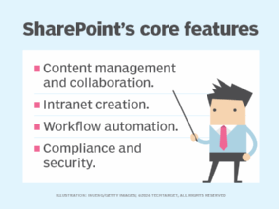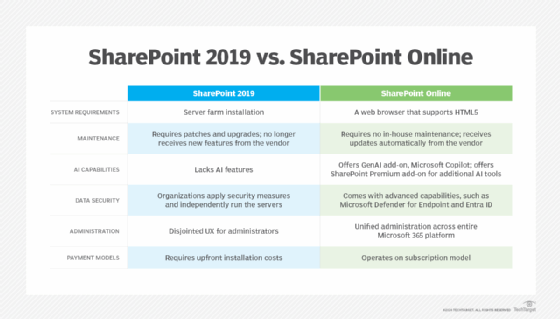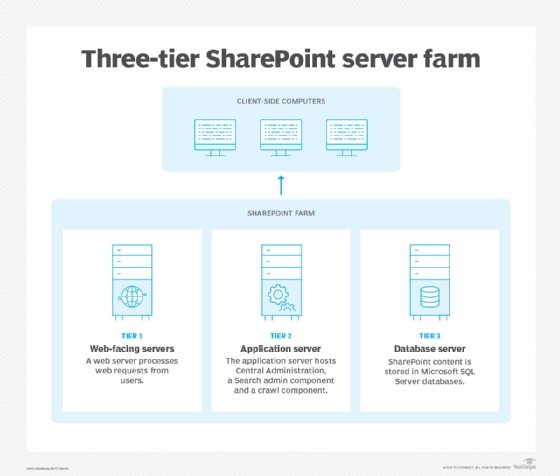What is Microsoft SharePoint and its important features?
Microsoft SharePoint is a document management and collaboration platform that helps organizations oversee, control and work with archives, documents, reports and other content that is vital to their business processes. Organizations across all industries, as well as individual departments within those organizations, have benefited from SharePoint's enterprise management and collaboration capabilities, helping them streamline operations and increase productivity.
SharePoint provides customers with customizable team sites for sharing news, data, files, links and other resources. Administrators can configure the SharePoint environment through a centralized web application, and end users can access SharePoint's features and capabilities through their web browsers. SharePoint enables organizations to manipulate content and site structure, create and delete sites, enable and disable product features, configure basic workflows and manage analytics.
SharePoint core features
SharePoint offers several features for organizing, accessing and sharing information across an organization. Users can connect to SharePoint resources from any device with a supported web browser or the SharePoint mobile app. They can access the SharePoint features and work with the site's content.

Although SharePoint supports a wide range of features, the following six categories represent the core capabilities that drive the SharePoint platform:
- Content management. SharePoint offers advanced content management capabilities that enable organizations to store and control their business content. Users can carry out a variety of tasks. For example, they can create folders, pin and move documents, configure custom data views, create document libraries, or add files as links, rather than copy them between sites.
- Collaboration and sharing. SharePoint provides effective collaboration and sharing features that enable users both inside and outside the organization to work seamlessly together, regardless of device type. SharePoint also provides native integration with Microsoft Teams, further enhancing collaboration.
- Intranet site creation. SharePoint enables organizations to create and maintain branded intranet pages and sites. Such a site provides an organization or team with a centralized platform for disseminating and sharing news, documents, updates, policy changes and any other information or resources they need to do their jobs.
- Search and discovery. SharePoint includes several features that enable users to quickly search for specific information and work with the results. They can sort and filter content, find relevant information, explore results without leaving search, and do much more.
- Workflow automation. SharePoint includes native features for automating business processes, such as routing documents for review. SharePoint also integrates with Microsoft Power Automate, a cloud-based service that enables users to create and automate workflows and tasks across multiple applications.
- Governance. SharePoint provides native governance capabilities that IT teams can use to streamline deployments, maintain security, manage compliance and support the organization's overall business goals.
Microsoft also provides many other features and resources that can benefit SharePoint customers and their users, such as SharePoint training materials, customization capabilities and developer resources.

SharePoint deployment options
SharePoint is available as either an on-premises software product or a cloud-based service. The platform can also be set up in a hybrid configuration that incorporates both options.
On-premises deployments
Microsoft introduced on-premises SharePoint in 2001. Since then, it has gone through multiple iterations, with new and improved features incorporated into each release. The latest update is SharePoint Server Subscription Edition, which became generally available in November 2021.
At the time, SharePoint Server 2019 was still actively supported. However, the 2019 edition moved from Mainstream Support to Extended Support in January 2024, which means it now receives only security updates (no feature or quality updates). SharePoint Server 2016 moved to Extended Support in July 2021. On July 14, 2026, Extended Support ends for both products, at which point, they will no longer receive any type of support.
Organizations still using SharePoint Server 2019 should already be thinking about how they'll move forward with the platform when the 2019 edition is no longer supported. Right now, they have two options: SharePoint Online or SharePoint Server Subscription Edition.
Microsoft generally favors a move to SharePoint Online. Although the company plans to release regular updates for the Subscription Edition, the improvements will generally focus on security and key customer scenarios. The scope of Microsoft's SharePoint investments will generally target SharePoint Online. As a result, the gap between the two products will continue to grow.
Despite these differences, some organizations will still prefer the on-premises edition, which is why Microsoft continues to update the Subscription Edition. When it was first released, this edition improved on SharePoint Server 2019 in a few areas:
- Authentication and identity management.
- Deployment and upgrade support.
- Farm administration.
- Health and monitoring rules.
- Hybrid deployments.
- PowerShell SharePoint administration.
- Search modernization.
- Security management.
- Sites, lists and libraries.
- Remote Share Provider for storage.
Since the initial release of the Subscription Edition, Microsoft has continued to release regular feature updates that brought improvements and new capabilities. For example, the latest feature update, Version 24H1, added custom branding in the Suite Bar, vertical customization in the search results, OpenID Connect integration with SharePoint certificate management, and the ability to collect customer feedback from SharePoint farm administrators.

Cloud-based deployments
Although SharePoint was originally offered as an on-premises solution, much of Microsoft's focus is now on SharePoint as a cloud service. The service is often referred to as SharePoint Online, but it is also called SharePoint as part of Microsoft Office 365 or simply SharePoint, depending on the source. Microsoft considers its online offering to be the "premier SharePoint experience," providing customers with the latest productivity, security and usability capabilities.
Microsoft offers SharePoint Online as a basic subscription service that's bundled with OneDrive and Microsoft Lists. SharePoint Online also comes bundled with most Microsoft 365 business and enterprise subscription plans, including Microsoft 365 Business Standard, Microsoft 365 Business Premium, Microsoft 365 E5 and Microsoft 365 F3. In addition, Microsoft bundles SharePoint Online with several Office 365 subscription plans, as well as government and nonprofit plans.
Microsoft continuously improves and enhances SharePoint Online, with immediate plans to add features related to intranet authoring, content creation, user engagement and platform flexibility. For example, Microsoft is working on capabilities such as page coauthoring for real-time collaboration, page toolbar extensibility, and a content pane that surfaces relevant authoring tools.
Microsoft SharePoint versions and history
SharePoint has existed in one form or another since it was introduced in 2001. It has grown to more than 190 million users within 200,000 organizations, according to Microsoft. Multiple SharePoint versions have been released over the 20-plus years. However, the first enterprise offering was not introduced until 2010, when Microsoft released SharePoint 2010 Enterprise.
SharePoint Server 2010 was closely integrated with Microsoft Office and Active Directory. It enabled organizations to quickly develop and build websites without programming knowledge. The websites could then be used to manage collaboration tools such as document libraries, discussion boards, shared task lists, shared calendars, blogs, wikis and surveys.
SharePoint 2013 was released as a collaboration platform for customized webpages in November 2012. The initial release of SharePoint 2013 offered a simplified user experience, as well as new enterprise social media capabilities. The 2013 edition expanded upon previously offered capabilities for website management, including shared calendars, blogs, wikis, surveys, document libraries and shared task lists.
SharePoint 2013 also launched with a community forum for users to communicate with each other and categorize discussions. It included microblogging and enhanced search capabilities, as well as e-discovery functionality, claims-based authentication and mobile support. The business intelligence (BI) tools in SharePoint 2013 enabled users to organize goals and processes and create customizable data models, reports and dashboards.
SharePoint Server 2016 shared much of the same code as SharePoint Online. As a result, on-premises customers received the same support and performance capabilities for their SharePoint server farms because there were few architectural differences. SharePoint Server 2016 is now in Extended Support, which ends July 14, 2026.
SharePoint 2019 was Microsoft's last nonsubscription SharePoint Server product. It brought more cloud-based features to the SharePoint Server, as well as hybrid architecture types. SharePoint Server 2019 is also now in Extended Support, which ends July 14, 2026.
SharePoint Server Subscription Edition is the latest edition of the SharePoint Server product. It is now the only fully supported on-premises SharePoint product and will likely remain the only one going forward. The Subscription Edition is based on Microsoft's modern engineering and support lifecycle, so it receives new and improved features on a regular basis.
Microsoft SharePoint competitors
Although SharePoint remains a market leader in document collaboration and management, many other cloud-based competitors have entered the market, including Box, ClickUp and Google Workspace. In addition, vendors such as Sitecore, Atlassian Confluence and WordPress compete with SharePoint in the web content management market.
The collaboration software industry has also grown, with other products gaining traction, including Salesforce Slack, Salesforce Chatter and Aurea Jive. Microsoft already recognized this trend in 2017 and released its own collaboration tool, Teams, to complement SharePoint 2016. Teams is still used in conjunction with SharePoint today.
Learn more about Microsoft SharePoint in this overview. Also, SharePoint integrates with several different collaboration tools. However, some businesses might find alternatives more useful, especially for easier migration to the cloud. Learn 10 alternatives to Microsoft SharePoint.






